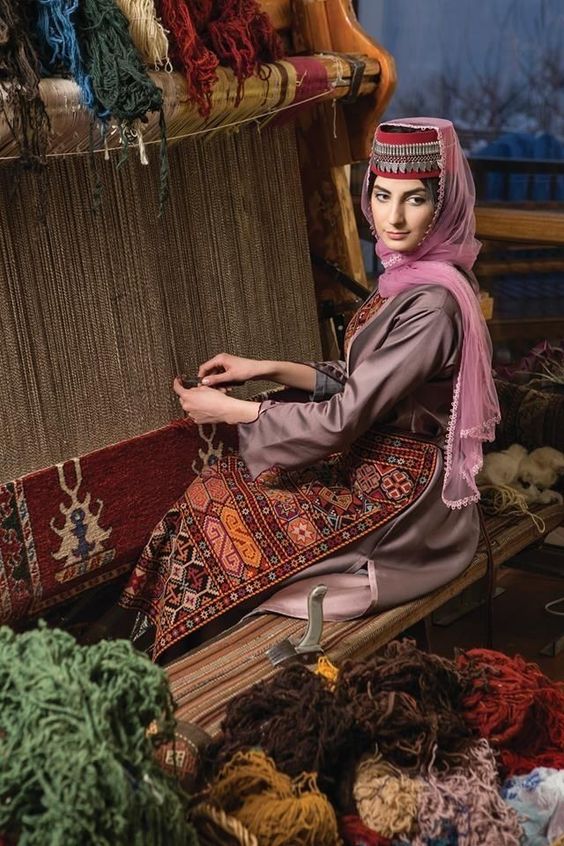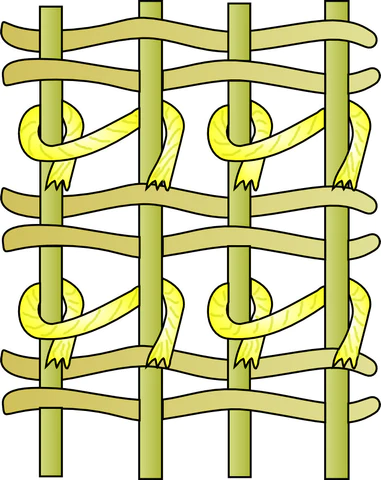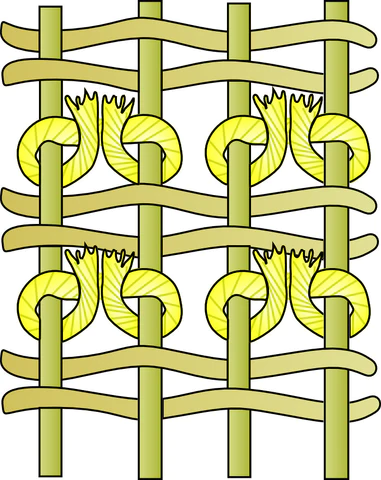How is a carpet’s structure made?

A carpet’s structure is created through the interlacing of warp and weft threads. The warp, which forms the rug’s base, comprises vertical threads firmly attached to the loom during production. These threads can be made of wool, cotton, or silk, depending on regional preferences and weaver choices.
The weft, composed of rows of knots, is formed by horizontally tying wool threads through the warp. The warp threads are only visible when viewing the rug’s reverse side.
What types of knots are used to weave a rug?
Compared to machine-made rugs, handmade rugs are strong and durable. The term “handmade” may sound a little self-explanatory, but it doesn’t tell the whole story of these incredible rugs! There are many types of rug knots. The knots your rug uses can say a lot about its origins.
There are several types of knots in rug making, but two of them are the most common. The type of knot used is largely based on the region, but this is not always the rule and you can find rugs that imitate other regions. This occurs with more modern rugs, where techniques have become more uniform across regions. The most common types are Persian and Turkish knots.
The knot known as senneh knot, asymmetrical knot or Persian knot is used in all carpets in the eastern and central and southern part of Iran, in India and in Central Asia.
In a Persian knot, one half of the thread is tied tightly around the warp while the other half is left loose. The result of this technique is that the asymmetrical knot can be bunched more tightly than Turkish knots, making Persian ideal for high knot density rugs with extremely detailed patterns. Both ends of the knots are visible on the front of the rug and make up the design you see.


The ghiordes knot is also called the Turkish or symmetrical knot. Turkish knots are most common in rugs made in northwestern Iran, by Kurdish weavers and, of course, in Turkey.
This knot completely envelops both pairs of warp threads and makes an extremely strong and durable rug, but it takes longer to weave than the Persian knot. This strong, symmetrical knot creates a very consistent weave and is generally used on thicker rugs.
Is one type of knot better than the other?
Neither Turkish knots nor Persian knots are necessarily better than the others. Both types of rug knots have pros and cons, with each being better suited to the style of rug weavers are accustomed to knotting.
Turkish knots are particularly strong and result in a consistent weave. However, the shape of the Turkish knot makes it difficult to roll or fold rugs. This makes Turkish knots more suitable for thicker rugs with more geometric designs, such as those found in Caucasian rugs.
Persian knots, on the other hand, tend to be more delicate. This makes them perfect for very thin rugs with high knot counts and with smooth or curvy designs.
And the fringes?
The base of the rug is formed by the warp, that is, by the threads that run from one end of the loom to the other and are tied to the loom. The fringe of rugs is formed by the remaining ends of these warp threads at both the top and bottom of the rug.

Figalli Oriental Rugs
We do not sell rugs. We bring rare works of art to your home in the form of rugs.
Our services
You are Protected
Copyright © 2023 Figalli Oriental Rugs, All rights reserved. Desenvolvido por Agência DLB – Agência de Marketing Digital em Porto Alegre
